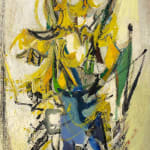Franz Josef Kline 1910-1962
Framed dimensions: 32 x 26 in
Franz Josef Kline was born in Wilkes-Barre, Pennsylvania in 1910. After his father’s death in 1917, the family moved to Lehighton, PA, and Kline was sent to the Girard College school for boys in Philadelphia. Kline often returned to his Pennsylvania roots in his paintings, but settled elsewhere, attending Boston University and the Heatherley School of Fine Art in London. In 1938, Kline moved to New York.
Kline found a community in New York, befriending artists such as Jackson Pollock and Willem de Kooning, who would eventually encourage Kline’s shift towards abstraction. Kline “loved New York and all the noise and confusion of life in the city” which is especially evident in his early paintings (John Gordon, Franz Kline 1910-1962). These early works, landscapes, street scenes, and portraits, were as lively and as compositionally interesting as his later black and white abstractions but rooted in the teachings of Kline’s conservative art education.
In the second half of the 1940s, however, Kline began his first experiments with abstraction. According to Elaine de Kooning’s 1962 account of Kline’s artistic ‘breakthrough’, Kline projected his small drawings into large scale with a “Bell-Opticon” (balopticon) projector, allowing him to visualize the loss and distortion of the “real” which results in the abstract. Kline moved into his mature abstraction more gradually than the account of his ‘breakthrough’ would suggest, but by 1950, he was given a one-man show at the Egan Gallery in New York which cemented his association with Abstract Expressionism.
Kline eventually returned to color, but remains best known for his black and white abstractions, "symbols of our culture, full of its strength and loneliness" (John Gordon, Franz Kline 1910-1962).
Still Life, c. 1946, is an early example of Kline’s foray into abstract art and demonstrates the gradual nature of his move away from figuration. Indeed, Still Life is the perfect marker of a transitional moment in Kline’s career; black and white strokes engage in dynamic dialogue with bright yellow, green, and blue, hinting at the monochromatic future of Kline’s work. All the electricity of Kline’s early street scenes and landscapes is also present in Still Life. The bright yellow flowers–– likely jonquils–– which are a recurring subject in Kline’s work, are formed freely and loosely and appear not so much still as in motion. Sir Herbert Read wrote that “Kline is open, moving out towards the edges of the canvas with a bursting energy” (Sir Herbert Read quoted in Gordon, Franz Kline). This may be seen at work in Still Life, in which the movement of the scene and of the paint itself is not localized but instead flows out from the blue vase and across the entire canvas. This picture, painted at an important moment in Kline’s career, provides a fascinating and exciting glimpse into the process of creative exploration. It walks the line between color and monochrome, figurative and abstract, traditional and modern, all while retaining the vivacity quintessential to Kline’s work.
Provenance
Private Collection (acquired directly from the artist);
Parke-Bernet Galleries, New York, Sale #2326, 27 January 1965, Lot 168;
Private Collection (acquired from the above sale);
Sotheby's, New York, Modern Discoveries, July 20, 2022, lot 490;
Private collectionPlease join our mailing list
* denotes required fields
We will process the personal data you have supplied in accordance with our privacy policy (available on request). You can unsubscribe or change your preferences at any time by clicking the link in our emails.



